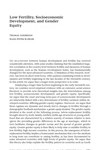-
The “Gender-Equity Dividend,” and the Education Effect on Climate Change Adaptation and Mitigation
October 27, 2015 By Deepshri Mathur By comparing “first wave” developing countries, like Sweden and the United States, to “second wave” developers, like South Korea and Japan, Thomas Anderson and Hans-Peter Kohler of the University of Pennsylvania seek to explain why countries that underwent socioeconomic development in the first half of the 20th century have slightly higher fertility levels than those that developed later. Despite “both sets of countries attaining high income and generally low fertility, contemporary gender norms and levels of gender equity differ between them,” write Anderson and Kohler in a new study in Population and Development Review. First wave developers have tended to stabilize at “moderately below” replacement-level fertility, they write, while second wave countries have continued to see fertility declines, creating major concerns about aging. The authors propose a new stage to the demographic transition called the “gender-equity dividend,” in which a period of relative scarcity of marriageable women creates conditions for advances in gender equity, which in turn helps stabilize fertility in high-income, low-fertility countries.
By comparing “first wave” developing countries, like Sweden and the United States, to “second wave” developers, like South Korea and Japan, Thomas Anderson and Hans-Peter Kohler of the University of Pennsylvania seek to explain why countries that underwent socioeconomic development in the first half of the 20th century have slightly higher fertility levels than those that developed later. Despite “both sets of countries attaining high income and generally low fertility, contemporary gender norms and levels of gender equity differ between them,” write Anderson and Kohler in a new study in Population and Development Review. First wave developers have tended to stabilize at “moderately below” replacement-level fertility, they write, while second wave countries have continued to see fertility declines, creating major concerns about aging. The authors propose a new stage to the demographic transition called the “gender-equity dividend,” in which a period of relative scarcity of marriageable women creates conditions for advances in gender equity, which in turn helps stabilize fertility in high-income, low-fertility countries. An article published in Population Studies finds that adapting to climate change might be easier for more educated people. Education “enables individuals to acquire knowledge, skills, and competencies that can influence their adaptive capacity and thus reduce risk,” write Wolfgang Lutz and Erich Strießnig. Building off the work of the Wittgenstein Center for Demography and Global Human Capital, they stress the importance of various near-term investments in education as an important but often ignored component of adapting to and mitigating the effects of climate change. Access to education leads to innovative technology and behavioral changes that positively affect climate change mitigation, such as clean energy and consumer patterns, they write. Improving education can also reduce fertility rates in less developed areas, consequently, reducing emissions and the number of people vulnerable to the effects of climate change. A reason why education has thus far been ignored in the climate change discourse goes back to earlier demographic studies where researchers only took into account “the absolute size of the population,” they explain, ignoring other demographic characteristics with respect to consumption and emissions patterns.
An article published in Population Studies finds that adapting to climate change might be easier for more educated people. Education “enables individuals to acquire knowledge, skills, and competencies that can influence their adaptive capacity and thus reduce risk,” write Wolfgang Lutz and Erich Strießnig. Building off the work of the Wittgenstein Center for Demography and Global Human Capital, they stress the importance of various near-term investments in education as an important but often ignored component of adapting to and mitigating the effects of climate change. Access to education leads to innovative technology and behavioral changes that positively affect climate change mitigation, such as clean energy and consumer patterns, they write. Improving education can also reduce fertility rates in less developed areas, consequently, reducing emissions and the number of people vulnerable to the effects of climate change. A reason why education has thus far been ignored in the climate change discourse goes back to earlier demographic studies where researchers only took into account “the absolute size of the population,” they explain, ignoring other demographic characteristics with respect to consumption and emissions patterns.Sources: Population and Development Review, Population Studies.
Topics: adaptation, aging, climate change, consumption, demography, development, energy, environment, gender, Japan, mitigation, population, Reading Radar, South Korea, Sweden, U.S.
 A Publication of the Stimson Center.
A Publication of the Stimson Center.








